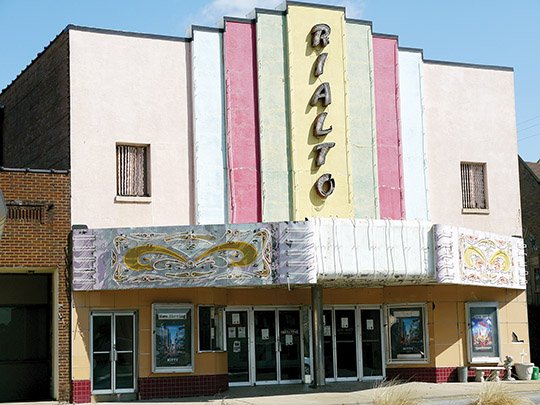SEARCY — Going to the movies didn’t always involve digital sound, stadium seating and 3-D glasses. Long before any of those things were commonplace, the Rialto Theater was bringing entertainment to Searcy.
What we now know as The Rialto was once the Grand Theatre. It was torn down in 1923 and rebuilt that same year. Within five years, the theater’s name was changed. The venue has also undergone changes and renovations, resulting in its present art deco facade and neon-lit marquee.
Main Street Searcy would like to see the Rialto restored to prime condition, said Amy Burton, the organization’s director. The theater is included on the National Register of Historic Places. Owned by the city of Searcy, the Rialto is one of only a handful of single-screen theaters in Arkansas to continue showing films on a regular basis.
“Funding is the No. 1 issue,” she said. “We want to completely renovate the structure. It needs more than a fresh coat of paint.”
Burton, who grew up in Searcy, has fond memories of time spent at the Rialto.
“I can remember waiting in a line all the way around the corner to get in and sitting in the balcony to watch movies,” she said. “It was a big part of my childhood.”
In its early days, the theater was home to more than just shows that appeared on the silver screen. Jasper, the most popular dog in pictures in the 1920s, paid a visit to the then Grand Theater. In addition to traveling vaudeville acts, in 1928 a mock wedding featuring two males was hailed as “holy confusion” and netted $66 for the public library fund, according to the book Searcy, Arkansas: A Frontier Town Grows Up With America, by Raymond Muncy.
The Rialto saw its share of silent films; but in 1929, it joined the increasing number of movie houses to feature talking pictures. The first such film at the Rialto was The Prisoners, starring Corinne Griffith.
The venue was also the site of a visit by Tex Ritter and his three musical tornadoes in 1939, and the Goldwyn-Mayer traveling motion-picture studio — a miniature Hollywood on wheels — made a stop in front of the Rialto as well, Muncy’s book recalls.
A contest to come up with a catchy motto for the Rialto was held in 1932, with free tickets offered for the 10 best entrants. The winner turned out to be “The best and coolest retreat is at the corner of Race and Spring Street.” The gimmicky motto perhaps took its inspiration from the cooling system that moviegoers were privileged to enjoy at the Rialto.
Searcy’s Little Miss Shirley Temple Contest was held at the Rialto in 1938, and the marquee of the theater was lit up by an additional 3,000-watt spotlight to give the theater more of a Hollywood appearance for the event, Muncy reports. The contestants arrived on the scene in new Chevrolets, and each theater patron had an opportunity to vote for his or her favorite “Shirley Temple.”
Like most communities of the day, Searcy held amateur talent contests, and Harry King was the official “gong ringer” for the shows at the Rialto. Research indicates, though, that he rarely, if ever, cut a performance short.
Some clergymen were said to be not too fond of the town’s growing fascination with Hollywood and allegedly gave unhappy glances to theatergoers in the Sunday pews. A local law was proclaimed that the Sabbath was to be honored by closing theaters on that day.
Despite the disdain of the more conservative element in Searcy, the Rialto continued to thrive, partly as a result of the competition between the Rialto and Plaza theaters. On Aug. 14, 1940, Rialto’s manager, K.K. King, delighted a crowd gathered outside the theater when he made good on a wager in which he had promised to climb to the top of the Rialto’s marquee and spend the evening there if the Rialto lost a battle to see which theater could draw the most patrons during a specified time.
Things weren’t all bad for King, however. Paramount Studios in Hollywood honored him with an original motion-picture script of Untamed. The document, which included the signatures of the stars of the film, including William Frawley of I Love Lucy fame, was displayed in the lobby of the Rialto for a time.
Changing times, and the appearance of multiscreen theaters with the latest in sight and sound technical advances, have meant that the Rialto has joined its counterparts in representing a time when the magic of entertainment was new, and going to the movies was a special event.
